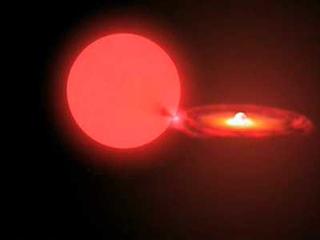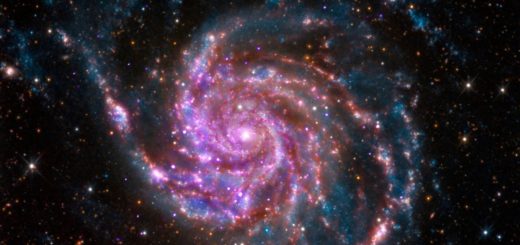How a Supernova Works

Humans are born, then we grow and die. Our life cycles are basically the same as those of the massive stars twinkling in the night sky — if we exploded in a blaze of glory at the end of our time, that is.
When the cosmos’ most colossal stars go out with a bang, the immense interstellar explosion is known as a supernova. While smaller stars simply fizzle out, the death of an astronomical heavyweight is a showstopper. It has spent its life cannibalizing its own innards — and sometimes the innards of a solar neighbor — for fuel. When there is nothing left for it to consume, it collapses in on itself and then explodes outward in a death knell that outshines other huge stars — and sometimes entire galaxies — for days, weeks or even months [source: Lemonick].
A supernova should, statistically, detonate once every 50 years or so in a galaxy the size of our Milky Way. However, until 2006, scientists believed the Milky Way’s most recent supernova occurred in the late 1600s [source: Goddard Space Flight Center]. They then realized that a clump of interstellar debris they’d been tracking for 23 years was actually the remnants of a supernova just 140 years old [source: NASA]. Astronomers couldn’t view the flare-up because of cosmic dust, which also blocks most of the 1 billion supernovae estimated to occur outside our galaxy every year [source: Odenwald].
In contrast, some supernovae are so bright that they can be seen with a simple set of binoculars. In September 2011, earthlings in the northern hemisphere could peer into the Pinwheel Galaxy — which appears above the Big Dipper’s handle but isn’t visible from most of the southern hemisphere — and see a supernova that detonated 21 million years ago [source: Perlman].
So how do you spot one? Identifying a new point of light as a supernova (as opposed to a high-flying aircraft or a comet) may be easier than you think.
It’s easy to use a star chart to identify constellations on a cloudless night. After all, the positions of these celestial objects have been mapped for centuries. But what happens when a guest star suddenly appears among its well-documented peers? It’s probably the remains of a star that exploded hundreds or millions of years ago, and whose light is only now reaching our skies.
It doesn’t take a professional degree to make an astronomical discovery. In January 2011, a 10-year-old girl found a supernova in a galaxy 240 million light-years away [source: Vincent]. Scientists often rely on backyard astronomers to patrol the skies for newly appearing pinpoints that are brighter and clearer than the objects around them. Stars about to go supernova change color from red to blue due to their increasing temperatures [source: Minkel]. And supernovae maintain some blue color due to the Doppler effect: The light from their explosions moves toward us so fast that it appears blue [source: Murdin]. Plus, unlike a comet or commercial airplane, a supernova won’t waver from its position.
If you spot a supernova that isn’t on record, you can report it to the IAU Central Bureau for Astronomical Telegrams. From there, astronomers will study any electromagnetic radiation that the potential supernova is giving off — that is, any gamma rays, x-rays, ultraviolet waves, visible light, infrared waves, microwaves and radio waves. This spectrum of visible and invisible radiation will help them learn about what the celestial object is composed of, how hot it is, how dense it is and how fast it’s moving.
Astronomers living in ancient China made the first record of a supernova some 2,000 years ago. They didn’t understand what they were seeing and were convinced that the point of light was a new one. However, after chronicling the “new” star for eight months, the object suddenly disappeared. Although this hide-and-seek star could have become a forgotten footnote, the discovery experienced a revival in 2006. That’s when astronomers realized they were looking at remnants of the same supernova that had been documented in ancient China [source: Zielinski].
Supernovae like this have been found all over the cosmos, in our galaxy and other galaxies millions of light-years away. In 1987, we discovered a supernova so close to Earth that it could be seen without looking through a telescope. This supernova was located in the Large Magellanic Cloud, neighbor to our Milky Way galaxy [source: Space Telescope Science Institute]. It made history again in 2011, when scientists discovered its debris glowing brighter as it entered a new stage of decay. The light of this supernova remnant became more visible because its leftover mass of debris expanded and bumped into a ring of debris that had been discharged from the supernova before it exploded. When the matter collided, it produced x-rays and heat, which caused the remnant to look brighter [source: Beck].
But how did this star begin to self-destruct in the first place? Learn about the life cycle of giant stars on the next page.



 Creators of mankind
Creators of mankind Description of “Tall white aliens”
Description of “Tall white aliens” Where they came from?
Where they came from? About hostile civilizations
About hostile civilizations The war for the Earth
The war for the Earth “Tall white aliens” about eternal life
“Tall white aliens” about eternal life Video: “Nordic aliens”
Video: “Nordic aliens” Aliens
Aliens Alien encounters
Alien encounters The aliens base
The aliens base UFO
UFO Technology UFO
Technology UFO Underground civilization
Underground civilization Ancient alien artifacts
Ancient alien artifacts Military and UFO
Military and UFO Mysteries and hypotheses
Mysteries and hypotheses Scientific facts
Scientific facts


















